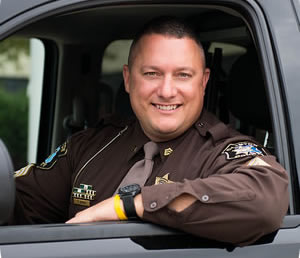Time to Heal
One Rogel Cancer Center patient's story of long-term treatment and coping with side effects

Sean Dush considers himself lucky when it comes to having been diagnosed with adult acute lymphoblastic leukemia. At 37, he experienced shortness of breath and swollen lymph nodes for just four days. His cancer was caught early. He responded to treatment and, after just a few months, received a clean bill of health from his oncologist, Dale Bixby, M.D., Ph.D.
"When I got to U-M and people found out I had four little kids, I told them I had no choice but to beat this," Dush says. "I believe God has healed me, thanks to Dr. Bixby and (Physician Assistant) Heather Fox."
With his cancer gone and no symptoms, Dush had a decision to make. His treatment protocol for ALL included maintenance therapy for three years to give him the best chance of being cured. But with long-term treatment comes long-term side effects.
"Even though these maintenance medications are often pills, they are still chemotherapy," says Bixby. "Patients often need blood monitoring to ensure stable kidney and liver functions and stable blood counts. Moreover, chronic side effects like gastrointestinal problems, fatigue and memory loss can become issues with specific medications."
Dush, then a road patrol sergeant for the Clinton County Sheriff's office, was unable to work nights because of his suppressed immune system and fatigue. He sometimes sleeps for 16 hours and still wakes up tired. He has come to expect 10-12 "bad" days every time he begins the 28-day regimen. He takes anti-nausea medication when needed. Dush credits the support of his family, friends and coworkers as the driving force behind keeping his life on track during treatment.
Now a detective, Dush investigates everything from low-level property crimes to homicides. Because he lives close to the Sheriff's department, he has the advantage of being able to go home and sleep during his lunch hour. He also eats well and walks four to five times per week.

With the end of his three-year maintenance period coming this December, was it worth it?
"I believe God put me in contact with Dr. Bixby for a reason and I'm going to listen to him. Even though the side effects can be tough, ALL has a 90 percent cure rate."
Bixby tries to ensure patients like Dush understand the goals of therapy and possible bumps in the road.
"With Sean, he has been the model patient," he says. "He never misses appointments, calls with side effects or questions, and makes sure he understands the plan."
Now 40, Dush has installed an in-ground swimming pool to thank his wife and kids for taking such good care of him during treatment. With his maintenance therapy almost behind him, the family plans to enjoy it for years to come.
Questions to Ask Your Doctor About Long-Term Side Effects
- Could someone in your office write down what treatments I received?
- Am I at risk of specific late effects?
- Are there any other doctors I should see, such as a cardiologist or endocrinologist?
- Are there any signs or symptoms I need to watch for?
Source: American Society of Clinical Oncology
Continue reading the Fall, 2013 issue of Thrive.
Cancer Center Resources to Manage Side Effects
- Symptom Management and Supportive Care Program
- Patient Education Resource Center
- PsychOncology Program
